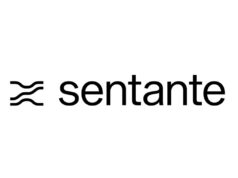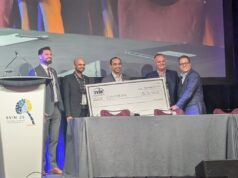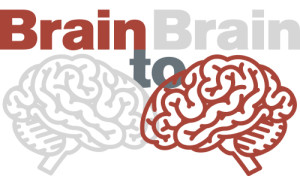 Since the emergence of positive data from the SENZA-RCT study pointing to the validity of high-frequency spinal cord stimulation for back and leg pain and the uptake of burst stimulation in Europe, the question has been raised whether there is still a place for traditional tonic spinal cord stimulation in the chronic pain care continuum. Here, Christophe Perruchoud and Adnan Al-Kaisy debate whether paraesthesia-free spinal cord stimulation is the future, or simply a phase.
Since the emergence of positive data from the SENZA-RCT study pointing to the validity of high-frequency spinal cord stimulation for back and leg pain and the uptake of burst stimulation in Europe, the question has been raised whether there is still a place for traditional tonic spinal cord stimulation in the chronic pain care continuum. Here, Christophe Perruchoud and Adnan Al-Kaisy debate whether paraesthesia-free spinal cord stimulation is the future, or simply a phase.
Paraesthesia-induced spinal cord stimulation is here to stay
By Christophe Perruchoud
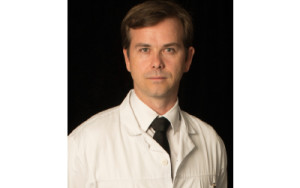
Conventional spinal cord stimulation (SCS) has dominated the field of neuromodulation during the past three decades and accumulated over time a significant amount of evidences of safety and efficacy. The robustness of the therapy rest on several solid pillars such as a coherent theory, a predictive model, different animal models, a human clinical verification and multiple randomised controlled trials (RCT) with long-term results in different indications.
Holsheimer1 developed a computer modelisation of SCS predicting that the recruitment of dorsal column fibres was most likely restricted to Aβ fibres in a 0.25mm layer under the pia mater. This limited stimulation is essentially due to the dissipation of the current in the cerebrospinal fluid. Still, according to this model, it is unlikely that, apart from dorsal roots and the thin outer layer of the dorsal column, any other spinal structures are recruited when stimulation is applied in the dorsal epidural space. Parallely different animal models of SCS for neuropathic, visceral or ischaemic pain have been studied and the works by Linderoth2 concluded to a Aβ fibres mediated suppression of central hyper-excitability via segmental inhibitory circuits, an antidromic vasodilatation and an orthodromic supraspinal activation of descending inhibitory pathways. Evidence exists for increased levels of gamma-amino butyric acid (GABA) release and serotonin, and for reduced levels of some excitatory amino acids, such as glutamate and aspartame. Measurements of evoked compound action potentials from the spinal cords of patients undergoing stimulation for pain relief contributed then to the human clinical verification of the therapy. Parker3 showed that Aβ sensory fibres were only recruited at therapeutic stimulation levels but not at subthreshold level. Moreover the Aβ potential amplitudes were correlated with the degree of coverage of the painful area.
Because of the inherent stimulation-induced paraesthesia, blinded studies are not realisable with conventional SCS. However several well designed RCTs are available in various indications. Kumar4 compared SCS with conventional medical management in patients suffering from failed back surgery syndrome (FBSS), with predominant leg pain of neuropathic radicular origin. At a two-year follow-up, 37% of the patients in the SCS group versus only 2% in the conventional medical management group achieved at least 50% in pain relief. In 2005, a systematic review of the literature by Taylor5 showed that SCS not only reduces pain, but also improves the quality of life, reduces analgesic consumption with minimal significant adverse effects, and may also result in significant cost savings over time. In another RCT by North6, SCS was also more effective for radicular pain following spinal surgery than either reoperation or conservative management.
One RCT7 investigated the efficacy of SCS in CRPS Type I and concluded that SCS in combination with physical therapy was more effective than physical therapy alone in reducing pain at six months and at two years. However, a five-year follow-up analysis revealed that the pain-relief of SCS decreased over time, and compared to the control group, this effect was no longer significant after three years of follow-up. Nevertheless, patients’ satisfaction at the five-year follow-up remains high and 95% of the implanted patients would repeat the SCS treatment.
Patients treated with SCS for inoperable peripheral vascular disease also demonstrated significant improvements in pain relief, quality of life and limb mobility8. A recent Cochrane systematic review9 concluded that compared to conventional management, SCS improved limb salvage at 12 months and more patients reached Stage Fontaine II.
Finally, there is RCT evidence10 in patients with refractory angina pectoris that SCS offers significant decreases in chest pain and hospital admissions as well as increased exercise tolerance, with less morbidity than coronary artery bypass grafting.
Since then, SCS has undergone various developments and new modes of stimulation have recently emerged, which can be classified either as non-tonic or high frequency (> 500HZ) stimulation. Burst stimulation has shown promise in FBSS, though the RCTs11,12 have looked at short-term results and the small number of patients preclude definite conclusions. As to high frequency stimulation, there are essentially prospective uncontrolled case series except for one industry-sponsored randomised head-to-head trial comparing 10-KHz high frequency with conventional SCS13. Conspicuous by their absence are blinded placebo controlled trials, even though the absence of paraesthesia would provide the ideal research conditions. In a world dominated by industrial interests, the incentive to be first is often stronger than the incentive to be right… Interestingly, the vast majority of implanters in Europe did not stop implanting conventional systems despite the excellent results published for burst or high frequency stimulation, indicating that more research is still needed to precise the mechanisms of action, specific indications and long-term efficacy. In the meantime, paraesthesia-induced spinal cord stimulation is here to stay.
Christophe Perruchoud, is at the Department of Anesthesiology and Pain Management, Center for Neuromodulation, Hospital of Morges, Switzerland
References
- Holsheimer J. Which Neuronal Elements are Activated Directly by Spinal Cord Stimulation. Neuromodulation. 2002 Jan;5(1):25-31.
- Meyerson BA, Linderoth B. Mode of action of spinal cord stimulation in neuropathic pain. J Pain Symptom Manage. 2006 Apr;31(4 Suppl):S6-12.
- Parker JL, Karantonis DM, Singl PS, Obradovic M, Cousins, Michael J. Compound action potentials recorded in the human spinal cord during neurostimulation for pain relief. Pain 2012 Mar;153(3):593-601
- Kumar K, Taylor RS, Jacques L, Eldabe S, Meglio M, Molet J, Thomson S, O’Callaghan J, Eisenberg E, Milbouw G, Buchser E, Fortini G, Richardson J, North RB. The effects of spinal cord stimulation in neuropathic pain are sustained: a 24-month follow-up of the prospective randomized controlled multicenter trial of the effectiveness of spinal cord stimulation. Neurosurgery. 2008 Oct;63(4):762-70.
- Taylor RS, Ryan J, O’Donnell R, Eldabe S, Kumar K, North RB. The cost-effectiveness of spinal cord stimulation in the treatment of failed back surgery syndrome. Clin J Pain. 2010 Jul-Aug;26(6):463-9.
- North RB, Kidd DH, Farrokhi F, Piantadosi SA. Spinal cord stimulation versus repeated lumbosacral spine surgery for chronic pain: a randomized, controlled trial. Neurosurgery. 2005;56(1):98-106
- Kemler MA, de Vet HC, Barendse GA, van den Wildenberg FA, van Kleef M. Spinal cord stimulation for chronic reflex sympathetic dystrophy–five-year follow-up. N Engl J Med. 2006 Jun 1;354(22):2394-6.
- Spincemaille GH, Klomp HM, Steyerberg EW, Habbema JD. Pain and quality of life in patients with critical limb ischaemia: results of a randomized controlled multicentre study on the effect of spinal cord stimulation. ESES study group. European Journal of Pain 2000; 4 (2):173-84.
- Ubbink DT, Vermeulen H. Spinal cord stimulation for non-reconstructable chronic critical leg ischaemia. Cochrane Database Syst Rev. 2013 Feb 28;2:CD004001.
- Mannheimer C, Eliasson T, Augustinsson LE, Blomstrand C, Emanuelsson H, Larsson S, Norrsell H, Hjalmarsson A. Electrical stimulation versus coronary artery bypass surgery in severe angina pectoris: the ESBY study. Circulation. 1998 Mar 31;97(12):1157-63.
- De Ridder D, Plazier M, Kamerling N, Menovsky T, Vanneste S. Burst spinal cord stimulation for limb and back pain. World Neurosurg. 2013 Nov;80(5):642-649.
- Schu S, Slotty PJ, Bara G, von Knop M, Edgar D, Vesper J. A prospective, randomised, double-blind, placebo-controlled study to examine the effectiveness of burst spinal cord stimulation patterns for the treatment of failed back surgery syndrome. Neuromodulation. 2014 Jul;17(5):443-50.
- Kapural L, Yu C, Doust MW, Gliner BE, Vallejo R, Sitzman BT, Amirdelfan K, Morgan DM, Brown LL, Yearwood TL, Bundschu R, Burton AW, Yang T, Benyamin R, Burgher AH. Novel 10-kHz High-frequency Therapy (HF10 Therapy) Is Superior to Traditional Low-frequency Spinal Cord Stimulation for the Treatment of Chronic Back and Leg Pain: The SENZA-RCT Randomized Controlled Trial. Anesthesiology. 2015 Oct;123(4):851-60.
Towards paraesthesia-free spinal cord stimulation… The new era of electrical neuromodulation in the 21st century
By Adnan Al-Kaisy
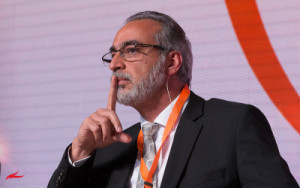
Traditional spinal cord stimulation (SCS) is a well-established paraesthesia-based treatment for chronic, neuropathic pain. However, the therapy has acknowledged shortcomings, including the need for the patient to continually experience paraesthesia overlap of their pain, and limited utility in the treatment of pain located predominately in the low back.
The objective of traditional SCS is to induce comfortable paraesthesia (defined as an abnormal sensation, often perceived by patients as “tingling”), that overlap the existing distribution of pain, by modulating neuronal activity. The success of traditional SCS in relieving pain has been correlated to the coverage of paraesthesia over the painful body area(s) [North et al 1991], as well as patient acceptance of the induced sensations [Mathew et al 2010]. While typically tolerable, paraesthesia can become bothersome or uncomfortable rather than soothing. These sensations can cause sleep disturbances, excessive and uncomfortable stimulation, and are sensitive to body position [Kuechmann et al 2009]. These challenges significantly hinder the efficacy of the treatment and patient’s confidence in the therapy. Moreover, achieving stimulation overlap of the lower back is recognised as technically difficult and may require complex electrode geometries and extensive psychophysical testing [Oakley 2004].
To this end, technical advancements in SCS systems over the last two decades or so attempted to address these challenges. To increase paraesthesia coverage over the lower back, electrode designs, such as octad leads, tripolar/multicolumn stimulation were introduced [Law 1992, Oakley et al 2006]. New placements were tried, such as subcutaneous positioning of electrodes over the low back region, using field stimulation to directly activate afferents in the referred body area for low back pain [Navarro & Vercimak 2012, Hamm-Faber et al 2015]. To counter paraesthesia discomfort, Medtronic launched AdaptiveStim technology which automatically adjusts amplitude, pulse width and electrode configurations to compensate for changes in the distance and orientation of the epidural stimulating electrodes to the movement of the spinal cord with postural changes, ostensibly to maintain optimal therapy energy [Schultz et al 2012].
What is the patient experience with current traditional SCS?
Many patients achieve satisfactory pain control of their limbs with use of traditional SCS, but with body position changes they may experience painful/uncomfortable stimulation, loss of stimulation and/or change in paraesthesia intensity/coverage. Patients typically respond by adjusting their stimulation frequently [Schultz et al 2012].
In a survey of 80 patients implanted with traditional SCS, 71% reported discomfort when they changed position (Kuechmann C, et al. Abstract. EFIC, 2009). Further, Kapural et al reported that 44% of the patients complained of discomfort at the first three months with the use of traditional SCS. This persisted at 42% at 12-months follow-up, indicating that patients cannot adapt to the discomfort of paraesthesia even at 12 months post-implant [Kapural et al 2015].
What is the difference between paraesthesia-independent and subthreshold stimulation programming?
Paraesthesia-independent means that paraesthesia is unnecessary for any aspect of successful SCS. That is, no intraoperative paraesthesia mapping is required for lead placement (i.e., stimulation leads are positioned at the anatomical midline using only intraoperative imaging); paraesthesia overlap of pain is not the technical goal during device programming (ie., instead of ‘where they feel the sensation,’ patients are asked about their relief of pain when stimulation programmes are being assessed); and the patient never experiences paraesthesia during their everyday use of SCS for pain relief. Currently, high frequency 10kHz spinal cord stimulation (HF10 therapy) is the only paraesthesia-independent therapy available on the market. Other paraesthesia-free therapies currently being explored, such as burst stimulation, ‘high density’ stimulation, ‘1200Hz subthreshold’ stimulation, et al, do require conscious patient cooperation intraoperatively to ensure that lead placement achieves paraesthesia coverage over the painful area [DeRidder et al 2013, Sweet et al 2015, North et al 2015]. Additionally, the goals of post-operative programming are still to optimise paraesthesia coverage over painful areas (Table 1).
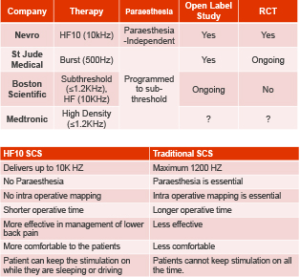
Is there any evidence that we do not need paraesthesia in order to get analgesia?
With the advent of HF10 therapy and burst stimulation, the paradigm of SCS is shifting as more patients are receiving paraesthesia-free SCS.
Patients with predominantly axial back pain recruited in a European multicentre cohort study and treated with HF10 therapy demonstrated statistically- and clinically-significant relief of their back pain sustained at two years follow up [Al-Kaisy et al 2014].
Most recently, the SENZA-RCT study provides the first scientifically rigorous, randomised, controlled trial demonstrating the superiority of HF10 therapy over traditional SCS in the long-term treatment of both back and leg pain. This FDA-approved randomised trial involving 198 patients is the biggest RCT in the neuromodulation therapy for chronic pain [Kapural et al 2015]. Moreover, we have demonstrated in a prospective open label pilot study that HF10 therapy can provide significant back pain relief, reduction in disability, improvement in quality of life, and reduction in opioids in nonsurgical chronic lower back pain patients who are suitable for SCS treatment [Al-Kaisy et al 2015].
A study by De Ridder et al has shown that when using 40Hz burst stimulation at five pulses per burst in patients with surgically implanted SCS, only 17% of patients perceived paraesthesia, as opposed to 92% when conventional stimulation was used. However, this therapy is paraesthesia-based, which includes paraesthesia mapping to overlap the existing distribution of pain [DeRidder et al 2010]. (Table 1)
There are a number of advantages of paraesthesia-free SCS compared with traditional tonic SCS (Table 2).
In conclusion, there is a clear paradigm shift of electrical neuromodulation demonstrating that analgesia can be achieved without paraesthesia. This is exemplified by the number of new paraesthesia-free SCS therapies presently being explored. Of course, the ultimate clinical value of any of these new therapies will depend upon whether they demonstrate robust, long-term efficacy in studies with high levels of evidence.
Adnan Al-Kaisy is a consultant in Pain Medicine and the director of The Pain Management and Neuromodulation Centre at Guy’s and St Thomas’ Hospital, London, UK

